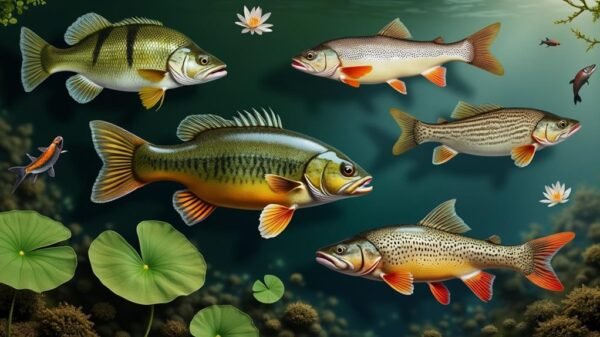Identifying freshwater fish can be simple and exciting when you know what to look for. Start by observing key physical traits like body shape, color patterns, and fin configurations. For instance, vibrant sunfish are smaller, while aggressive largemouth bass are larger and more streamlined. Next, consider their habitats—catfish often hide in muddy waters, while trout prefer cool streams. Seasonal changes also impact fish behavior, so keep an eye out during spawning times. Use handy tools like mobile apps or field guides for quick references. With these tips, you're on your way to becoming a fish identification pro! There's so much more to discover!
Understanding Common Freshwater Fish Species
When you venture into freshwater environments, identifying the common fish species is essential. Recognizing these species enhances your fishing journey and fosters a deeper respect for nature. Among the most sought-after freshwater game fish are the largemouth bass, known for their aggressive behavior and streamlined bodies, making them a top choice for anglers.
Then, there's the sunfish, smaller and vibrant, providing an enjoyable catch, particularly for novice fishermen. Catfish, identifiable by their whisker-like barbels, often hide in murky waters, adding intrigue to your fishing escapades.
Trout flourish in cooler, clear waters and are admired for their striking colors. If you find yourself near rivers or lakes, keep an eye out for northern pike, recognized for their sharp teeth and predatory instincts.
Understanding these fish species allows you to choose the appropriate bait and techniques, enhancing your time spent fishing. So, gather your gear and let the excitement of exploration lead you as you connect with the lively aquatic life beneath the surface. The vastness of the outdoors awaits with every cast.
Key Physical Characteristics to Observe

Observing key physical traits of freshwater fish can significantly improve your identification abilities. By focusing on specific characteristics, you can uncover the unique aspects of various species. Freshwater fish are often classified by their preferred water temperature, which influences their physical features. Here are some essential attributes to consider:
- Body Form: Fish display a variety of body forms, ranging from slender and elongated to compact and circular. This variation can help you narrow down your identification options.
- Coloration: The colors and patterns on a fish's skin serve as important indicators. For example, species like the warm-water bream and bluegill exhibit distinctive stripes or spots, making them easily recognizable.
- Fin Configuration: The dimensions, shapes, and number of fins can provide valuable insights. Certain species, such as the common carp, possess long dorsal fins or uniquely shaped tails that stand out.
Utilizing Habitat Clues for Identification

Understanding a fish's environment offers vital hints for identification. When exploring rivers, lakes, or ponds, observe the surroundings. Various aquatic species flourish in distinct habitats. For instance, if you notice a fish in a muddy area filled with plants, you could be encountering a catfish or a sunfish, both of which enjoy hiding amongst greenery and debris. Additionally, familiarizing yourself with common fish species in rivers enhances your identification skills.
Next, examine the water's current. Rapid streams typically harbor fish like trout, while sluggish waters may host bass or bluegill. The temperature and clarity of the water are also crucial factors. Cold, clear lakes often attract species that thrive in cooler conditions, while murky waters may draw fish that can endure lower visibility.
Seasonality plays a role too. During spawning periods, certain species may move to shallow waters in spring. By recognizing these environmental clues, you'll enhance your ability to identify the fish you encounter. Embrace the joy of exploration and apply these insights to connect more deeply with the aquatic ecosystem around you. Happy fishing!
Recognizing Color Patterns and Markings

Many freshwater fish, such as the brook trout and bluegill, display unique color patterns and markings that are essential for identification. These visuals enhance your fishing or wildlife-watching experiences. Focus on the colors and patterns on the fish's body. Some species boast vibrant hues, while others, like the catfish, may have more muted tones that allow them to blend into their habitats. Familiarizing yourself with the various species found in local lakes and ponds can boost your identification skills, as different ecosystems often showcase distinct patterns.
Here are a few tips for recognizing color patterns:
- Stripes and Spots: Species such as the brook trout exhibit prominent spots or stripes, which are vital for identification.
- Body Shape and Size: The overall physique often aligns with the color patterns, aiding in the identification process.
- Color Changes: Many species can change colors based on their surroundings or mood, so it's important to look for consistent traits over time.
Quick Reference Tools for Fish Identification

For a successful fishing trip or wildlife observation, having quick reference tools at your fingertips can greatly enhance your experience. Equip yourself with essential guides that simplify fish identification. Field guides, whether in print or digital format, are crucial. Seek out those that showcase clear images and concise descriptions of local freshwater species, including bluegill and crappie.
Mobile applications such as Fishbrain or Angler's Log can be game-changers. Many offer an intuitive interface where you can input characteristics like color, size, and habitat. These apps often feature a built-in camera capability, allowing you to capture an image and receive instant feedback about the fish you encounter.
Another valuable tool is a fish identification chart. Hang one on your boat or in your tackle box for quick reference. These charts typically organize fish by body shape or color patterns, enabling you to identify the species more swiftly.
Don't overlook local fishing forums or community groups on platforms like Facebook or Reddit! Connecting with fellow anglers can provide invaluable insights and tips. With these resources at your disposal, you'll feel empowered and ready to explore the waters confidently. Happy fishing!



























